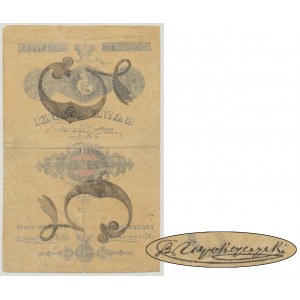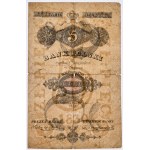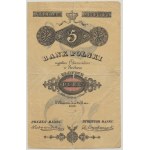A prized, rare and sought-after banknote from the period of the Kingdom of Poland, noteworthy still denominated in zlotys.
An extremely typologically necessary item, being practically the only attainable denomination of an issue dated 1830. Signature of the bank director Niepokoyczycki.
Offered piece excellent, even beautiful in its class. Broken several times by the field with clear delamination of the paper on the line of the horizontal and vertical break, which should not be surprising given the delicacy of the paper used for printing.
The vast majority of pieces offered on the auction market are banknotes after conservation treatments. The banknote that is the subject of the auction is an item not only preserved in its full natural state of preservation, but also with all the characteristics of printing freshness.
The paper has retained its full natural cream-brown color, such a piece we did not have in the auction offer. The colors of the printing are exquisitely preserved, almost book-like, contrasting beautifully with the color of the paper. Nevertheless, it is the quality of the dry stamp that makes the offered piece unique. The dry stamp in the form of a double-headed eagle is perfectly legible and convex. Many collectors do not even realize that these banknotes bear a dry stamp, which is a direct result of the fact that the vast majority of known pieces are banknotes very much affected by circulation and in parallel after conservation adjustments.
Without a doubt, the offered banknote is one of the ornaments of our Premium Session in the Polish paper money section. An item that collectors include in their collection regardless of its state of preservation, while in full printing freshness it is a banknote for the best collections of Polish banknotes. In our opinion, the offered piece is the freshest piece that has been auctioned in Poland. The only better preserved piece we have seen is a piece from the Czapski Collection in Cracow. Phenomenal banknote, whose naturalness will delight even the most seasoned and experienced collectors. The auction of such a preserved 5 zloty note from 1830 will unquestionably go down in the summary of our XII Premium Auction!
In 1815, the Kingdom of Poland was established, united by a personal union with the Russian Empire. State separateness was abolished after the fall of the November Uprising. Only administrative separateness was retained. After the January Uprising, it too was abolished.
The idea of introducing paper money in the Kingdom of Poland appeared in 1821. In this way it was wanted to pay off the debts of the governments of the Duchy of Warsaw, which had to be settled by the Central Liquidation Commission. On April 15, 1823, Tsar Alexander I issued a decree under which he established cash tickets in Polish zlotys.
Denominations: 5, 10, 50 and 100 zlotys with the issue date of 1824 were printed at the Assignment Factory in St. Petersburg. Originally, a commission of 2% of their value was to be deducted when they were exchanged for bullion coins. In the end, it was not decided to put them into circulation. This was done only by the Bank of Poland, established in 1828.
After the opening of a bank of issue in the Kingdom of Poland, the total circulation of paper money proved too small. In addition, the tickets printed in 1824 were made on poor-quality paper and were easily damaged. For this reason, tickets with a new design were prepared with an issue date of May 1, 1830. Unlike previous issues of paper money, these tickets won full public trust. Contributing to this was the possibility of permanent and full exchange for bullion money at the bank's cash desks without deducting commissions when exchanging them.
Cash tickets from 1824 were in the form of a lying rectangle surrounded by a decorative frame. Their designs were modeled on Russian asignats. They were the first paper money printed on both sides. At the top, in the center of the frame, there is a circular field with the coat of arms of the Kingdom of Poland. In 1828, new paper money designs were created on which the White Eagle was missing. It can be found on the dry seal of the Bank of Poland as part of the coat of arms of the congressional kingdom.
After the outbreak of the November Uprising, the population hoarded bullion money, which forced the issuance of paper money of low denominations. The national government authorized the Bank of Poland to issue denominations of 1 and 2 zlotys. However, only the lower denomination with the annual date of 1831 was put into circulation. This was the only banknote of the sovereign Polish state in the 19th century.












